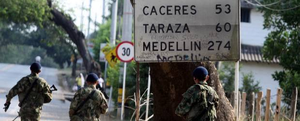
On January 1, a Colombian anti-narcotics squad killed Juan de Dios Úsuga (alias “Giovanni”), the leader of the Urabeños, one of the most powerful groups formed out of the demobilized Colombian paramilitary, the United Self-Defense Forces of Colombia (AUC). In response to the killing, the Urabeños unleashed a wave of violence and threats over the last week, demonstrating the intimidating power of this criminal group.
In the six Colombian departments of Antioquia, Chocó, Magdalena, Córdoba, Cesar, and Sucre, the Urabeños shut down transportation with an armed strike in an unprecedented show of force that surprised many. These same departments have been the historic hot beds of paramilitaries and narco-traffickers for over a quarter century. It is clearer now that the strength of these groups has not diminished in recent years, but rather increased. The recent Urabeños violence throws into question the staged demobilization of the AUC, which started in 2005 and was concluded by 2007 with much fanfare.
 It is estimated that the Urabeños operate in 95 municipalities in the six aforementioned departments, with an army of about 1,600 armed men and an estimated annual income of $15 million. The Colombian police estimate that throughout the country, six paramilitary groups (including the Urabeños), have a total of roughly 6,000 armed personnel, which operate in 150 municipalities in half of the country’s 32 departments.
It is estimated that the Urabeños operate in 95 municipalities in the six aforementioned departments, with an army of about 1,600 armed men and an estimated annual income of $15 million. The Colombian police estimate that throughout the country, six paramilitary groups (including the Urabeños), have a total of roughly 6,000 armed personnel, which operate in 150 municipalities in half of the country’s 32 departments.
Several points should be highlighted about the continuous growth of Colombia’s paramilitary groups:
1. This phenomenon is occurring in spite of the rhetoric of “democratic security and consolidation” and the myth of demobilization espoused by former president Álvaro Uribe Vélez (2002-2010) and his successor Juan Manuel Santos.
2. As long as narco-trafficking is a profitable enterprise, the incentives for crime will continue, particularly if the costs of such activity are low. The Urabeños charge about $16,000 per kilogram of cocaine that they ship to Panama. When it gets to Mexico this kilo is sold for $40,000. In Miami, the price is up to $80,000. However, when this kilo of cocaine is delivered to Urabá, Colombia, a major transit point, it is priced at about only $1,800.
3. These groups are deeply rooted in several departments and form part of the local power structures with profound links with local authorities and political elites. This makes the fight against the paramilitaries and nacro-traffickers all the more complex, and it is a major reason that a different approach is needed to minimize the power of these groups.
4. As long as there is an armed conflict the possibility for the rule of law and good governance are overshadowed by the dynamics and political economy of the war system, which these groups form part of alongside the state and the insurgency.
The exit strategy is clear: Drugs must be legalized or decriminalized and a settlement to the current conflict must be negotiated that can provide the Colombian people a better future with social justice.
For more from Nazih Richani's blog, Colombian Cuadernos, visit nacla.org/blog/cuadernos-colombianos, or see the NACLA Report July/August 2009, "Coercion Incorporated: Paramilitary Colombia." Here's an interesting timeline on the Urabeños, by InSight.

